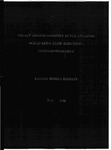Cobalt biogeochemistry in the Atlantic Ocean using Flow Injection-Chemiluminescence
| dc.contributor.supervisor | Lohan, Maeve | |
| dc.contributor.author | Shelley, Rachel | |
| dc.contributor.other | Faculty of Science and Engineering | en_US |
| dc.date.accessioned | 2011-08-19T10:00:38Z | |
| dc.date.available | 2011-08-19T10:00:38Z | |
| dc.date.issued | 2011 | |
| dc.date.issued | 2011 | |
| dc.identifier | 297595 | en_US |
| dc.identifier.uri | http://hdl.handle.net/10026.1/538 | |
| dc.description.abstract |
As ~ 50% of global photosynthesis occurs in marine environments, the factors regulating this process e.g. trace metal availability, have an impact on the global carbon cycle. The key cyanobacteria genera Prochlorococcus and Synechococcus have an absolute requirement for Co. Dissolved cobalt (dCo) concentrations in the open ocean are extremely low (5–120 pM). A sensitive flow injection technique using chemiluminescence detection (FI-CL) was developed (detection limit 4.5 pM dCo, RSD ≤ 4%). Seawater samples must be UV-irradiated prior to analysis, in order to liberate organically-bound Co. A field study in the Sargasso Sea, demonstrated that aerosol Co was significantly more soluble than aerosol Fe over a range of aerosol dust deposition fluxes (1–1040 μg Fe m-2 d-1) (8-100% for Co versus 0.44-45% for Fe). The dry deposition flux of aerosol Co was of the same order of magnitude as the advective upwelling flux (47-1540 pmol m-2 d-1 and 1.7-1430 pmol m-2 d-1 respectively). Wet deposition, dominated the total aerosol flux (~ 85%). The vertical distribution of dCo influenced Prochlorococcus abundance. A regional study in the eastern North Atlantic gyre demonstrated that the highest rates of N2 fixation occurred with the highest dFe concentrations (9.8 nM N L-1 h-1, 0.6 nM respectively). No increase in primary production following additions of trace metals (Co, Cu, Fe, Zn) was observed. The addition of N resulted in an increase in primary production. However, there was no synergistic effect of trace metal plus N addition, suggesting that alleviation of N-limitation shifted the system to P-limitation. On a meridional transect from ~ 50°N–50°S in the Atlantic Ocean, the highest concentrations of dCo (> 80 pM) coincided with low-O2 (< 150 μM) upwelled water. The lowest dCo (< 20 pM) was observed in the eastern North Atlantic gyre. Lateral advection of continental Co and upwelling were identified as important sources of Co. The highly efficient recycling of Co in the euphotic zone is an important additional source. | en_US |
| dc.language.iso | en | en_US |
| dc.publisher | University of Plymouth | en_US |
| dc.subject | Biogeochemistry | |
| dc.subject | Flow Injection | |
| dc.subject | Cobalt | en_US |
| dc.title | Cobalt biogeochemistry in the Atlantic Ocean using Flow Injection-Chemiluminescence | en_US |
| dc.type | Thesis | |
| dc.identifier.doi | http://dx.doi.org/10.24382/3298 |
Files in this item
This item appears in the following Collection(s)
-
01 Research Theses Main Collection
Research Theses Main


